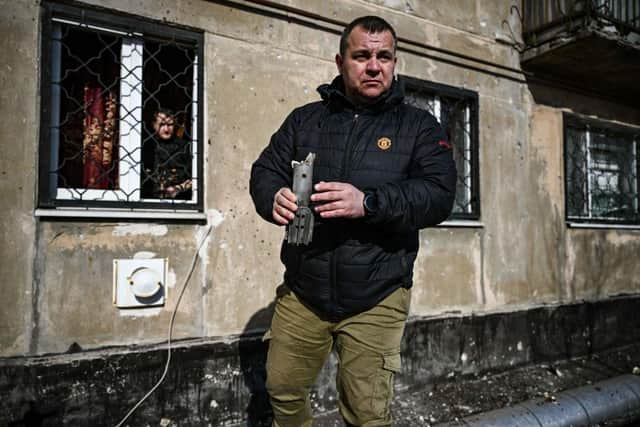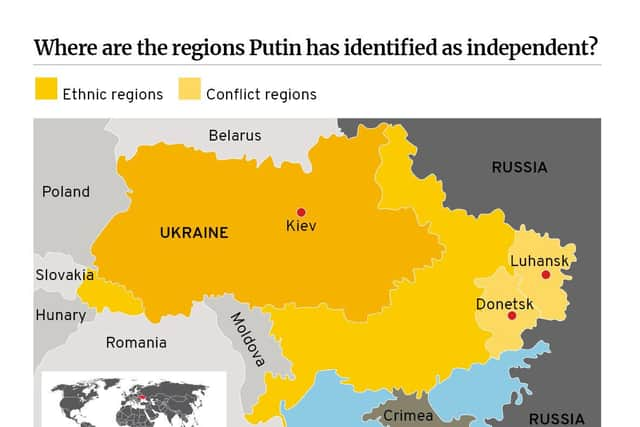Ukraine crisis: Why has Russia invaded Ukraine and what does President Vladimir Putin want?
He told citizens that Russia – specifically former leader Vladimir Lenin – had created modern Ukraine and claimed the nation had never had genuine independent statehood.
He and his officials painted a picture of Ukraine as a country with a puppet government controlled by the West that was struggling economically.
Advertisement
Hide AdAdvertisement
Hide AdThe People’s Republic of Ukraine was created in 1917 in the aftermath of the Russian Revolution. However, it did not gain full independence until 1991, when the Soviet Union collapsed and breakaway states declared independence from Moscow.


For the past 30 years, Ukraine has operated as an independent nation – albeit one with constant tensions in its relationship with neighbouring Russia.
The most recent escalation of the crisis has come following Mr Putin’s demands from the West that Ukraine be banned from ever joining Nato, a defence alliance of 30 countries. The country also has plans to join the European Union, stating last year that it would aim to formally apply for membership in 2024, in order to join the European Union in the 2030s.
On Monday night, Mr Putin dismissed Nato’s claims of being a “peace loving and purely defensive alliance”, saying he believed that if Ukraine were to join Nato in the future, which Nato committed to do at a 2008 summit in the Romanian capital of Bucharest, “the level of military threats to Russia will dramatically increase many times over”.


For many Ukranians, the recent talk in the West of fears of an imminent Russian invasion of their country is meaningless – as far as they are concerned, it was invaded eight years ago through Mr Putin’s annexing of Crimea and rebel uprisings in the Donbas area of the country – and the continued threat has never gone away. In fact, more than 14,000 people have been killed during the conflict since 2014.
In late 2013, protests broke out in the Ukrainain capital Kyiv after then-Ukrainian president Viktor Yanukovych suspended moves to sign an association agreement between Ukraine and the European Union – and instead forged closer ties with Russia.
Known as the Euromaidan, the protests continued, sparking demands for the resignation of Mr Yanukovych and calling for a halt to widespread government corruption and a reform of human rights in Ukraine.
In February 2014, an Agreement on Settlement of Political Crisis in Ukraine was signed by the government and opposition, in mediation carried out by Russia and the European Union. Mr Yanukovych subsequently fled the country and the Ukrainian government held early elections the following May.
Advertisement
Hide AdAdvertisement
Hide AdTwo days after the signing of the agreement, Mr Putin moved in to annex Crimea, a peninsula in the north of the Black Sea.
Troops moved in and a controversial referendum was held, which found 97 per cent of the population wanted to be part of Russia.
Russia drew up a treaty of accession for the region. The UN General Assembly immediately responded by passing a resolution declaring the referendum was invalid – however, this was not enforceable, due to a Russian veto on the UN Security Council.
Around the same time, in the eastern regions of Donetsk and Luhansk in the Donbas, support for the pro-European government was also deemed to be lower than in central parts of Ukraine. Pro-Russian protests were held and rebels declared control and held referendums over the future of the regions, with those referendums not recognised internationally.
Meanwhile, Ukraine’s government, led by Petro Poroshenko, was moving into closer alignment with the West. The Ukraine-EU agreement was ratified and Mr Poroshenko set 2020 as a target for Ukrainian membership of the EU.
In January 2015, an agreement was signed in Minsk, Belarus, between Mr Poroshenko and the rebel separatists, declaring a ceasefire. As a result, the breakaway republics of Donetsk and Luhansk would have been given special status inside Ukraine – although these moves were still being ironed out.
However, by stating on Monday night that he plans to recognise the independence of Donetsk and Luhansk, following televised requests from the leaders of the regions, Mr Putin has broken the peace agreement signed in Munich. By doing so, he is set to trigger sanctions from the West, including the UK.
Russia has subsequently moved troops into the two breakaway regions, claiming they were peace-keeping forces. However, international governments have insisted they do not believe that to be the case.
Advertisement
Hide AdAdvertisement
Hide AdIn addition, there is debate around whether the recognition of the regions will include a larger territory than is currently occupied due to historic border changes, meaning even taking the breakaway regions could be seen as a move further into Ukrainian territory.
Around 150,000 Russian troops are deployed around Ukraine’s borders, including in Belarus, an ally of Russia, where the southern border lies close to the Ukrainian capital of Kyiv.
Western leaders have warned they believe Russia could mobilise troops not only in the eastern regions, but in Belarus and Crimea, with US President Joe Biden stating that he believes Kyiv specifically is likely to be targeted.
"We believe that they will target Ukraine's capital of Kyiv – a city of 2.8 million innocent people," Mr Biden said earlier this week.
President Putin’s demands about Nato membership also apply to the former Soviet state of Georgia, to the south of Russia. A five-day war in 2008 saw Russian troops invade Georgian territories. Of all of the former Soviet states, however, Ukraine is the largest and most significant for Russia.
A message from the Editor:
Thank you for reading this article. We're more reliant on your support than ever as the shift in consumer habits brought about by Coronavirus impacts our advertisers.
If you haven't already, please consider supporting our trusted, fact-checked journalism by taking out a digital subscription.
Comments
Want to join the conversation? Please or to comment on this article.
